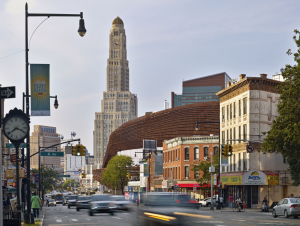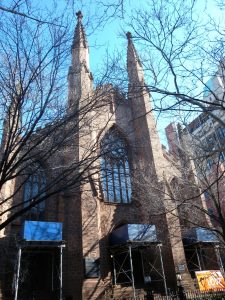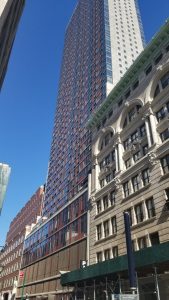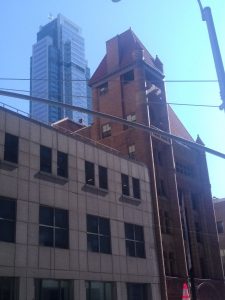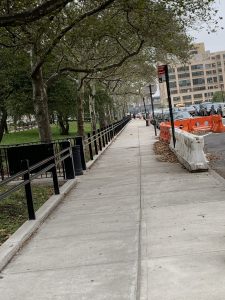To get here from City tech, you’ll have to leave the school from the Johnson st exit, then across the street and you’ll find yourself on Adams st, and quickly back on Johnson st. You then walk down a block on Johnson st and make a left turn and find yourself towards the west of Cadman Plaza, so you across the street, make a right, and make your way onto Pierrepont st. From there you walk 4 blocks down, and that’s when you’ll reach 70 Pierrepont st, where i took this picture.
This picture is a great example of Juxaposition because it shows two diffrent buildings next to each other. On the left side, you see an old type of brick design, and by looking at the building, you can tell it’s been around for quite some time. And on the right side, you see a more modern look type of building, with a newer look to it.
I did a little bit of research and found out that 70 Pierrepont street has history that dates all the way back to 1925, and is one of the most expensive places to live in Brooklyn to date. And it’s been said that great literary writing was started in Brooklyn Heights, and many of the great and influential writers such as Walt Whitman, was inspired by brooklyn, “Brooklyn Heights has been a writers’ paradise since the days of Walt Whitman in the 1840s. “He drew energy from Brooklyn,” reported Evan Hughes in “Literary Brooklyn.” Whitman worked at Rome Brothers, a print shop on Cranberry and Fulton streets where, in his off hours, he set type for a long, wild poem that would become “Leaves of Grass.” His daytime job as editor at 26 of the Brooklyn Daily Eagle lasted until he was fired for criticizing the publisher’s politics. Walt, an elementary school dropout, struggled to support his family. They led a peripatetic life moving in the Heights from Front Street to Henry to Adams to Tillary. In subsequent years, other writers followed Whitman’s pattern in Brooklyn Heights, often moving close to their peers. This literary history was recounted by John Gardiner in the Brooklyn Heights Press in 1983 in a review of the book, “Literary New York,” by Susan Edmiston and Linda Cirino. Gardiner wrote about anecdotal encounters with famous celebrities: Thomas Wolfe, Arthur Miller, Norman Mailer and Norman Rosten. These literary giants of yesteryear created an aura that prevailed in Brooklyn from the 1920s to this day.” Best said by writer John B. Manbeck….
https://brooklyneagle.com/articles/2019/08/06/writers-brooklyn-heights/
One article that supports my project is, “Here, Property And Priviege Are Neighbors; Income Gaps Are a Source Of Resentment and Guilt” by Janny Scott, she state “The intricate geography of income difference in New York City is something Chastity Davis absorbed early, growing up in the 1980’s in a tenement apartment in Boerum Hill, Brooklyn, on a block of mostly brick row houses flanked by public housing projects at either end.” Also, “A defining characteristic of New York City is its economic diversity, the juxtaposition of people of disparate circumstances in limited space. The gap between top and bottom is greater in New York than in most cities in the country, and people at the extremes often live closer together.”
I agree with those statements because, New York may be a beautifully built city, but it is very hard to live in. New York is known as one of the most richest and sprawling cities in the U.S due to it’s economic success over the years, so living in New York comes with the certainty of going broke. So many people resort to living is less diverse neighborhoods, such as project housing, with bad living conditions. As shown in my photo above, there are two completely different buildings against each other. One looks so clean with a nice white stone design, presumably built just recently, or not too long ago rather, and the other building has a worn out brick design, presumably built a while ago, there’s nothing enticing about this building. Obviously, you can make an assumption that there’s some sort of economic difference between these buildings, people who live in the brick buildings don’t pay too much for living expenses, whereas the people who live in the white stone building pay a ton.


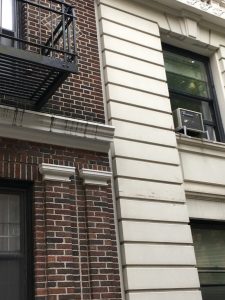 .
.



